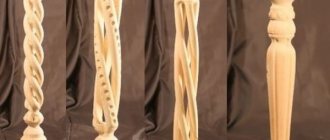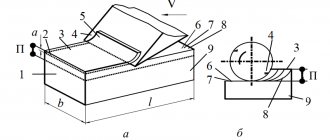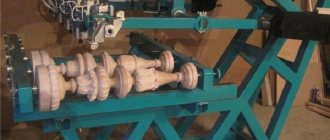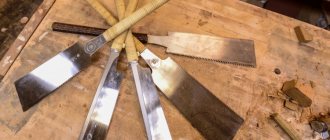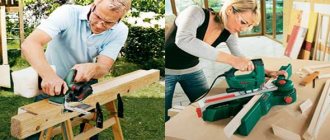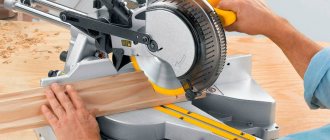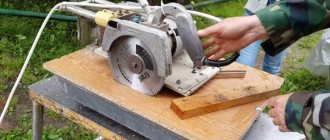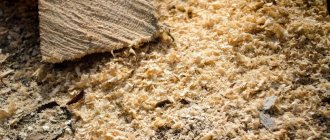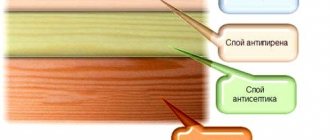Having a milling machine really simplifies the work of inserting hinges, forming complex holes, recesses, wood carving, etc.
But this does not mean at all that it is necessary to have professional and expensive equipment: it is enough to have a simple manual device. The only thing you need is to be able to basicly handle wood and use power tools. In addition, you need to have a desire, otherwise without this there will never be a result. Those who have no desire to work simply buy furniture or hire craftsmen to, for example, install a new door and cut locks. Any work, especially with power tools, requires certain knowledge, and especially safety precautions.
Why do you need a milling machine?
The milling device is designed for processing both wood and metal. With its help, it is possible to form recesses or holes of any configuration. This greatly simplifies tasks such as inserting hinges and inserting locks. Doing this with a chisel and an electric drill is not so easy, and it takes a lot of time.
There are stationary milling devices and portable (manual). Hand-held electric milling machines are considered universal devices, with the help of which, in the presence of attachments, it is possible to perform operations for various purposes; you just need to change the position of the part in relation to the device or vice versa.
Stationary devices are used in factories or factories where mass production of wood or metal products is established. Under such conditions, the cutting attachment is stationary, and the workpiece moves along the desired path. When using a hand tool, on the contrary, the part is fixed motionless and only then it is processed, although there are parts that require fixing a hand tool. This is provided for in the design, therefore, it is considered more universal. This is especially true when a large number of parts need to be processed, and it is not possible to use a stationary machine.
A homemade milling machine is a horizontal platform with a hole in the center, to which a hand-held device is attached from below.
There are many types of milling machines, but for use at home or for starting your own business, universal models are more suitable. As a rule, they are equipped with a set of cutters and various devices for performing various types of operations. The only thing is that if you have a manual milling cutter, simple operations can take much longer than when using a stationary machine.
Using a manual milling device it is possible to:
- Make grooves or recesses of any shape (curly, rectangular, combined).
- Drill through and non-through holes.
- Process ends and edges of any configuration.
- Cut out complex shaped parts.
- Apply drawings or patterns to the surface of parts.
- Copy parts if necessary.
Copying parts is one of the functions of any electric milling machine.
The presence of such functions makes it possible to simplify the production of the same type of furniture or the production of identical parts not related to furniture production. This is one of the main advantages of this tool. As a rule, to produce parts of the same type, it is necessary to install copying machines, which are designed to perform only one operation, which is not always profitable, especially in small enterprises.
Care
A hand router is an unpretentious device that does not require too complex or specialized maintenance. The main care for it consists of cleaning it from dust and chips, timely replacing the brushes on the motor and checking the bearings on the motor shaft and cutters. It is necessary to ensure the cleanliness of the guide rods and the ease of movement of the router along them.
Some experts advise covering the rods with a layer of lubricant, but this is a rather controversial advice, since dust and small wood particles will begin to stick to it. It is more correct to clean the rods with a brush moistened with turpentine, which dissolves tree resin and removes fine dust.
In conclusion, it is necessary to recall that a manual milling machine is a universal multifunctional machine that has a lot of capabilities and is capable of performing complex operations. With its help, complex parts, artistic panels and other crafts and products that require high qualifications and experience are made.
Gradually, skills and experience are developed, leading to the complication of work operations and obtaining more effective results. If at first the router is used to a minimum, this does not mean anything - one day it will perform complex professional tasks.
Getting started and caring for the tool
To understand how this device works, you should familiarize yourself with its main parts and their purpose.
Composition and purpose of main components
A manual milling device consists of a metal body and a motor, which is located in the same body. A shaft protrudes from the housing, onto which various collets are placed, serving as adapters. They allow you to install cutters of various sizes. The cutter is inserted directly into the collet, which is secured with a special bolt or button, which is provided on some models.
The main elements of a manual milling device and their purpose.
The design of the milling device includes a metal platform, which has a rigid connection to the body. It is attached to the body by means of two rods. On the outside, the plate has a smooth coating that ensures smooth movement during operation.
The manual milling device has some characteristics that can be adjusted:
- Due to the handle and scale for adjusting the milling depth. Adjustment is carried out in 1/10 mm increments.
- By adjusting the rotation speed of the cutter.
At the initial stages, when mastering the tool, it is better to try to work at low or medium speeds. Although you should always remember that the higher the speed, the better the work. Especially if this concerns critical, visible areas that cannot be masked.
In addition to these levers, there is also a button to turn the product on and off, as well as a lock button. These elements are considered basic, ensuring high-quality and safe performance of work. There is also a parallel stop, which contributes to ease of use. It can be rigidly fixed or with the ability to adjust the shift of the working area away from the center.
Caring for a hand-held milling device
Usually, a factory product ends up in the hands of a person tested and lubricated, so no additional measures should be taken. Only during its operation you need to monitor its cleanliness and serviceability. At the same time, it should be regularly cleaned of dust and the lubricant should be changed, if so written in the passport. Lubrication is especially necessary for moving parts. As an option, you can use aerosol lubricants, but you can also get by with regular ones, such as Litol. The use of thick lubricants is not recommended, as chips and dust stick to them. If aerosol lubricants are used, then this factor can be eliminated.
The sole, the smooth part of the body, also requires lubrication. Regular lubrication will ensure smooth movement.
Despite this, the purchased item should definitely be checked for quality of assembly and presence of lubricant.
Unfortunately, not all manufacturers, especially domestic ones, care about build quality. There are cases when, after the very first hours of operation, screws or screws are unscrewed from a product because they were not tightened properly.
Rotation speed adjustment
The operation of any tool is associated with certain conditions related, first of all, to the nature of the material being processed. It can be plywood, composite material or regular wood. Depending on this, the rotation speed on the electrical appliance is set. As a rule, the technical data sheet always indicates the operating parameters of the device, depending on the technical characteristics and characteristics of the surfaces being processed, as well as the cutters used.
Indicators of processing speeds when using various cutters.
Fixing the cutter
The first thing the work begins with is installing and securing the cutter. At the same time, you should adhere to the basic rule - all work is performed with the cord plug removed from the socket.
The cutter is installed according to certain marks, and if they are missing, then to a depth of no less than * the length of the cutter itself. How to install a cutter on a specific model can be found in the instructions, which must be included in the technical documents for the device. The fact is that each model may have its own design features and it is not possible to talk about this in the article.
Installing the cutter on the device before starting work.
There are both simple and more “advanced” models, as they say. Some models have a shaft rotation lock button, which makes installing the cutter easier. Some, especially expensive models, are equipped with ratchets. So it won’t be possible to specifically describe the process of installing the cutter, and it doesn’t make sense, since everyone who is familiar with the operation of such devices will figure it out in a moment.
Milling depth adjustment
Each model has its own maximum milling depth. At the same time, it is not always the maximum depth that is required, but a certain depth that is set before work. Even if maximum depth is required, in order not to overload the device, the milling process is divided into several stages, changing the milling depth in steps. For adjustment, special stops are provided - limiters. Structurally, they are made in the form of a disk located under the bar, on which stops of various lengths are fixed. The number of such legs can be from three to seven, and this does not mean that the more there are, the better. It is better if it is possible to adjust each of the legs, even if their number is minimal. To secure this stop in the optimal position, you should use a lock in the form of a flag.
The process for adjusting the milling depth is as follows:
- The tool should be placed on a flat surface, after which the clamps are released and the cutter is pressed with your hand so that it rests against the surface.
- By unscrewing the lock, the turret stop is released.
Choosing a turret stop leg. - The leg that corresponds to the milling depth is selected, after which the disk with the legs is installed in the correct position.
- In this case, the screw is not fixed, and the bar is held with a finger. After this, the movable pointer moves so that its readings coincide with the zero mark.
- Then the rod rises to the mark that corresponds to the milling depth and only then the turret stop lock is lowered (photo below).
Thus, the workpiece is milled to a given depth.
On high-quality, expensive models there is a wheel for precise adjustment of the milling depth.
Using this wheel, you can more accurately set the depth without disturbing the previous setting.
This wheel (green in the photo above) allows you to adjust the depth within small limits.
Choosing an electric milling machine
In order to mill at home, it is recommended to choose a universal tool, which is an electric router with an interchangeable base - plunge and edge, thanks to which it performs any type of woodwork, depending on the selected type of cutter.
It is better if it has speed control, work with a cutter with a diameter of at least 8 mm, the optimal power should be 800-1300 W. When choosing a tool, you should pay attention to the actual immersion depth of the cutter, on which the maximum depth of the resulting groove will depend. The best option for clamping the cutter is a conical collet, and for the switch - a locking button. The smoother the operation of the rod mechanism, the more durable the tool.
An important point in the operation of an electric milling machine is the correct choice of a cutter, which consists of a cylindrical shank of various diameters (6.8 or 12 mm) and a part with a cutting edge.
According to their design, cutters are divided into the following types:
- Monolithic
- Prefabricated
- With replaceable blades.
Depending on the type of processing performed by the cutter, it also comes in several varieties:
- A groove cutter is used to form grooves.
- Profile - to give the edge a decorative profile.
- Edge and seam cutters are used to process the edges of the product.
- Filling – for cutting a “U”-shaped notch on the product.
- The cone cutter bevels the edge of the product at an angle of 45 degrees.
- Moulded – forms a rounded edge.
Milling cutters for hand milling tools
A milling cutter is a cutting tool that can have an intricately shaped cutting edge. As a rule, all cutters are designed for rotational movements and therefore have a cylindrical shape. The shank of the cutter, which is clamped in the collet, has the same shape. Some cutters are equipped with a thrust roller, so that the distance between the cutting surface and the material being processed remains constant.
Milling cutters are made only from high-quality metals and their alloys. If you need to process soft wood, then HSS cutters will do, and if you need to process hard wood, then it is better to use cutters made of harder HM alloys.
Each cutter has its own technical characteristics, which provide it with high-quality and long-lasting performance. The main indicator is the maximum speed of its rotation, which should never be overestimated, otherwise its breakdown is inevitable. If the cutter is dull, you should not try to sharpen it yourself. Sharpening of cutters is carried out using special, expensive equipment. After all, you need not only to sharpen the cutter, but also to maintain its shape, which is no less important. Therefore, if for some reason the cutter becomes dull, it will be cheaper to buy a new one.
The most popular cutters
There are cutters that are used in work more often than others. For example:
- Edge cutters. With their help, the end surfaces of wooden blanks are cultivated. In addition to the curved edge, they can be used to form spikes or grooves to connect parts. Such cutters may have a bearing at the end that rests on the part, setting the processing distance.
Some types of edge cutters. - Groove cutters. These are cutters for forming grooves of various shapes. They, in turn, are:
- Spiral (a) - used to form technical grooves, such as tongue/groove.
- Fillet (b, d) - used for finishing surfaces in the form of grooves of various shapes and depths. They can be rounded, V-shaped or curly.
- Dovetail (c, d) - used to create a specially shaped groove intended for hidden or open connection of wooden parts.
- Shaped (d) - intended for decorating wooden surfaces. As a rule, they help create free-form grooves.
Groove molds are designed to create recesses in any location on the workpiece.
There are cutters that are simple, monolithic, made from a single piece of metal, and there are typesetters. Set cutters consist of a shank, which serves as the basis for a set of cutting elements. By selecting cutting planes and installing them on the shank, using washers of various thicknesses, you can form an arbitrary relief on the surface of the workpiece.
A set cutter is a set of cutting surfaces and washers that allows you to assemble a cutter of the desired shape.
In fact, there are a lot of cutters and this is only a small fraction of what is produced. All cutters differ in the diameter of the shank, the diameter of the cutting surfaces, their height, the location of the knives, etc. As for manual milling equipment, it is enough to have a set of five of the most common cutters. If necessary, you can purchase them at any time.
What can you do with a router yourself?
The main types of work that are done with the help of a router are a selection of profiles of different configurations - semicircular concave and convex, curly, slotted straight, etc.
- figured profile along the edge of window sills, table tops, stool seats, book, telephone and other shelves, cutting boards, railings and stair railings, any pieces of furniture and interior design;
- grooves and tenons for connection along the entire length like a lining, at the ends in the corners, in the middle (under jumpers - drawers);
- applying patterns and ornaments with a cutter with a semicircular tip (fillet) or with another profile;
- selection of recesses for fitting door and frame hinges, handles and locks;
- processing of straight and curved edges, for example, cut with a jigsaw, a milling cutter of any profile with a limit bearing at the end.
Rules for working with hand milling tools
Working with power tools requires special rules, especially when there are rapidly rotating elements. In addition, as a result of work, chips are formed that fly in all directions. Despite the fact that most models are equipped with a protective shield, this does not fully protect against the flow of chips. Therefore, it is better to work with such a tool wearing safety glasses.
The photo shows a model where a vacuum cleaner is connected to remove chips.
General requirements
If you follow the basic requirements for safe work with an electric hand router, the end result will please you with the quality of work and a safe outcome. These are the conditions:
- You should always use only sharp tools. How sharp a cutter is can be judged by the quality of the surface treatment. In addition, in such conditions the engine begins to get very hot.
- The material that needs to be processed must be securely fastened, otherwise normal operation will not occur.
The use of clamps for fastening the workpiece. - It is not recommended to remove the entire surface in one pass, as this increases the load on the cutter and the tool (motor). This entails a decrease in processing speed, and therefore a decrease in quality. Therefore, if the depth is decent, then it is better to remove the excess several times.
- The cutter is replaced only when the unit is de-energized, and turning it off with a switch alone is not enough. It is necessary to remove the plug from the socket.
The requirements are not very complex and quite feasible, but ignoring them means exposing yourself to danger. And one more thing, no less important, is the ability to hold a milling tool in your hands and feel how it works. If serious vibrations are felt, then you need to stop and analyze the reasons. It is possible that the cutter is dull or there is a knot. Sometimes it is necessary to correctly set the rotation speed of the cutter. Here you can experiment: either add speed or reduce it.
Preparation
To install the cutter in the chuck, the router is laid on its side. Some types allow you to disconnect the engine with the cartridge from the platform without changing its settings. Others do not provide this option, so most often you have to lower the base as far as possible. The cartridge is unscrewed using a wrench, which is included in the package.
The cartridge is fixed in immobility using a special button located above the point where the shaft exits the housing. It is not present on all types of milling cutters; sometimes you have to fix the shaft with a wrench and unscrew the chuck with another.
It is not necessary to remove the union nut completely, but sometimes this has to be done if the cutter is clamped too tightly in the collet. By gently tapping on the side surfaces and turning the shaft, the collet is loosened and the jammed cutter is removed.
The nut is screwed on, the new cutter is inserted into the collet approximately 20 mm. Some cutters on the shanks have special marks indicating the minimum and maximum immersion depth, but most of them are installed by eye. If the installation depth is too small, sharp feed may cause deformation of the cutter and damage to the workpiece. This is dangerous, since the maximum rotation speed of the router shaft is 30,000 rpm or more. A cutter flying out of a collet while moving has great destructive power; if it hits a person, the consequences can be very undesirable.
Attention! It is prohibited to screw the union nut without a cutter installed, as this will break the collet.
Setting the milling depth is as follows:
- The router with the base lowered is installed on a flat platform;
- The cutter is lowered all the way and fixed;
- The depth indicator slider is set to zero;
- The depth stop is raised to the required amount and locked with a screw;
- The cutter is unlocked and lowered until the depth stop stops against the adjusting screw, after which it is fixed again.
It is recommended to check the set depth on a test piece so that adjustments can be made if necessary. You should not immediately make the depth too large; this will cause the router to overheat and create an excessive load on the electric motor. The recommended depth per pass is 4-6 mm.
Edge processing: using templates
It is better to process the edges of a wooden board using a surface planer. If this is not possible, then you can use a hand router, although this will take some time. These works are carried out both without a template and with a template. If there are no skills or very few of them, then it is better to use a template. For processing edges, straight edge cutters are used, both with one bearing at the end of the cutting part and with a bearing at the beginning (see photo).
Edge cutters.
You can use an already processed board or other flat object as a template. Moreover, the length of the template must be greater than the length of the workpiece, both at the beginning and at the end of the workpiece being processed. This will avoid unevenness at the beginning of the edge and at the end. The most important thing here is that the template or object acting as a template has a smooth and even surface. In addition, its thickness should not be greater than the gap located between the bearing and the cutting part.
The width of the part is less than the length of the cutting part
Moreover, the longer the cutting part, the more difficult it is to work with the tool, since more effort is required. In this regard, it is better to start working with cutters that have an average length of the cutting part. The operating principle for edge processing is as follows:
- The template is attached so that it is at the desired height and has a flat horizontal surface.
- The template is firmly mounted to a table or other surface.
- The cutter with the roller is installed so that the roller moves along the template, and the cutter (cutting part) moves along the workpiece. To do this, perform all the necessary manipulations with the template, workpiece and tool.
- The cutter is installed in the working position and clamped.
- After this, the tool turns on and moves along the template. In this case, you should decide on the speed of movement, which is determined by the depth of processing.
- The milling unit can be either pushed or pulled, depending on what is convenient for you.
After the first pass, you should stop and evaluate the quality of the work. If necessary, another pass can be made by adjusting the position of the tool. If the quality is satisfactory, then the clamps are removed, freeing the workpiece.
Using this approach, it is possible to remove a quarter along the edge or in some of its parts. This is done by setting the cutting edge so that it extends to the required depth into the part.
Quarter shot on a furniture façade.
If you replace the cutter with a shaped one and move the guide, as well as use a stop, you can actually apply a longitudinal pattern to the part (pictured below).
Applying a longitudinal figured pattern to the workpiece.
If you use a similar milling technique (with a template), you can easily master the technique of working with wood in general. After some time, you can abandon the templates, since their installation takes a lot of useful time.
How to make a straight edge without a template: you can’t do this without experience.
The width of the part is greater than the length of the cutting part
Quite often, the thickness of the workpiece is greater than the length of the cutting part of the cutter. In this case proceed as follows:
- After the first pass, the template is removed and another pass is made. In this case, the template will be the already processed part. To do this, the bearing is guided along the machined surface. If the cutting part was again missing, then another pass will have to be made.
- For final processing, you should take a cutter with a bearing at the end, and the workpiece should be turned upside down, after which it is secured with clamps. As a result, the bearing will move along the machined surface. This approach makes it possible to process thick parts.
The bearing is guided along the machined surface, and the cutting edge processes the rest of the workpiece.
In order to master the work of a hand milling tool, you will need a lot of rough blanks, which you don’t mind throwing away later. No one succeeded the first time. To achieve anything, you need to train hard.
Achieving Various Shaped Edges
If a figured edge is required, which is most likely necessary, then first pay attention to the condition of this edge. If it is uneven, then you will have to level it and only then begin to form a curved edge by selecting the appropriate cutter.
Rounded edge.
It is necessary to prepare the surface so that the cutter does not copy the curvature along which the roller will move. In this case, a sequence of actions is needed, otherwise a positive result will not work.
If you need to process a frankly curved surface, then you can’t do without a template. It can be cut from plywood, about 10 mm thick, by first applying a pattern and cutting out the template with a jigsaw. The edge of the template must be brought to perfection using a hand router.
Drawing on plywood.
To mill a curved edge, first use a router without a template, carrying out the so-called rough processing. After this, the template is fixed and the workpiece is processed finally. If there are places where you need to remove a lot of material with a milling cutter, then these places can be cut out with a jigsaw.
Working with a hand router using a template
What kind of work can be done with a wood router?
Step-by-step technologies for work performed with a hand-held wood cutter: cutting grooves, sharpening ends and edges, inserting locks, tongue-and-groove joints.
Work on sampling open and blind grooves
To mill an open groove in a wooden workpiece, the following algorithm works:
- Lower the milling cutter head to the desired depth, securely fixing the workpiece.
- Connect the machine to the power supply, start the engine and start milling.
- After the cutter has completely made the groove, it is raised and the clamp clamp is loosened.
- Turn off the router.
Open recess
Using the same principle, a blind groove is selected, with the difference that work begins not from the edge, but from the beginning of the planned recess.
Sampling deep grooves
Before cutting a deep notch in a wooden part, it is worth starting from the basic principle. Each pass of the milling machine attachment across the processed area of a wooden workpiece requires setting a new depth indicator. In this case, at the time of adjustment, the milling cutter must be turned off.
To obtain a smooth surface of a deep groove, the recommended immersion value is from 5 mm. But the last layer should be processed at a depth of up to 1.5 mm.
Cutting a narrow groove
To select a small-width groove in a wooden workpiece with a milling cutter, additionally use a flat base. We are talking about a plywood sheet or a thin wooden slab. This device is attached to the base of the milling machine. To ensure that the router attachment moves in a straight line, special guide rods are mounted on both sides of the base, which must be at the same distance from the cutting attachment and must be in line with it. It is also worth making sure that the rods are evenly pressed against the sides of the wooden workpiece being processed.
Help base with guide rods
Sharpen the end
To properly process the end side of a wooden product with a router, it is enough to follow two principles:
- First, a shallow cut is made. The manual milling machine is driven in the direction of movement of the cutting attachment. These actions will allow you to obtain a uniform removal of the wood layer on the end surface.
- To clean the end, the router is driven against the direction of rotation of the cutting attachment.
How to make decorative trim
Thanks to the good flexibility of wood, craftsmen can mill designs and patterns of varying complexity and shape on this material.
Decorative finishing
In addition to a manual wood milling machine, the work requires several auxiliary tools:
- vice;
- chisel;
- jigsaw
The work of cutting out decorative trim with a wood router consists of three main stages:
- Transferring the image to a wooden surface so that it is well printed. An option is to use a stencil, tracing the contours of the pattern with a black alcohol-free marker.
- The router is moved along these contours, achieving the desired pattern.
- Removing wood layer by layer gives the image more volume.
Lock installation work
Using a hand-held wood router, you can also cut grooves for the future lock. This procedure is performed in the following order:
- The tool needs to be fitted with a straight groove cutter with a diameter 0.5 mm larger than the lock plate.
- Set the immersion depth to 3 mm.
- Attach the parallel stop to the machine sole.
- Place the lock plate on the end side of the door and trace its outline with a pencil.
- Find the center of the door edge and draw a line through it along the door leaf.
- A wood router with a parallel stop is installed on the end of the door. The cutter is centered along the marked line, the stop is fixed in this position.
The milling machine is placed on the end of the door
- The entire length of the treated area is milled. The result will be a wide recess of small depth for the front plate of the lock.
- A lock is applied to the resulting groove and the starting and ending points of the deep recess are marked.
- Install a straight groove cutter for wood with a diameter slightly larger than the thickness of the mortise lock body. The shank of the equipment must be of such length that it is possible to select a groove with a depth of 3 mm greater than the height of the lock body.
- Clamp the cutter in the collet.
- Using the regulator, set the immersion depth, which will be sufficient to insert the lock body.
- Drill at the specified depth along the entire length of the section.
- After working, the cutting part should be slightly pulled out of the groove by 1-2 mm, and several passes with the router should be made back and forth. Then the cutter plunges deeper again and the procedure is repeated. This is done to obtain even walls and the bottom of the groove.
Ready groove for the lock
Types of hand routers
When deciding which router is best to choose, you should keep in mind that all such devices may fall into one of the following categories:
- top type milling cutters;
- manual edge milling cutters;
- lamellar milling power tools.
Processing overhangs with an edge router
The top type manual electric router can be stationary or submersible. The design of a stationary type milling cutter includes an electric motor connected through elements of the kinematic circuit of the device to a chuck in which the tool being used is fixed. Such a milling cutter is called stationary for the reason that the tool in it does not have the ability to move relative to the body of the device. Using such a router is quite difficult, since the depth of processing performed when using it has to be adjusted manually, manipulating the entire device, which can be quite heavy.
Much more convenient to use is a plunge router, the drive motor of which is mounted on special guides and can move along them along with the working attachment during processing. The design of plunge-type milling machines also has a special spring, which ensures the lifting of the working nozzle after processing with its help is completed. If, in the process of purchasing top-type milling cutters, you choose which one is better, then you should definitely pay attention to submersible models, which are perfect for both professionals and beginners.
Plunge router controls
The edge milling machine, in full accordance with its name, is used for processing the edges of products and chamfering them. By equipping an edge router with working attachments of various types, you can process not only straight, but also shaped surfaces. In particular, using such a router and the corresponding cutting tool, you can make skirting boards and process shaped door panels.
A lamellar milling cutter, which is used primarily to create various grooves on the surface of the workpiece, is a highly specialized power tool.
Forming grooves for keys with a lamellar router
Thus, today the consumer is offered various types of milling cutters, the design of each of which is designed to solve specific technological problems. Knowing the answer to the question of why you need a router, you can always choose exactly the model that will fully meet your needs.
When choosing a router, you should not forget that its functionality and ease of working with it will also depend on the additional accessories that you will use with the power tool. Such devices, which, in particular, include various stops, clamps, templates, guides, etc., allow processing to be performed with higher accuracy and safety.
Making a device for picking out a tenon
When parts are processed manually, the milling cutter itself does not have additional spatial fixation. But the overall result of the work and the accuracy of the connection itself in the future depend on this.
To assemble the simplest design that can cope with the task, you will need to use:
- Several guides that remain stationary. They should be side and top or bottom.
- The length of the sample is adjusted through the use of an appropriate movable bar.
For manufacturing, the following sequence of actions is used:
- A plywood sheet is taken, from one edge of which the side elements are mounted in a vertical plane. It is necessary to create appropriate cutouts in the center of the material.
- The sides are equipped with guides. The base of the hand cutter moves along them later.
- The side strips are fixed on the upper guides. Then the movement of the working milling cutter associated with these parts becomes limited.
- The plywood sheet, which became the basis for the installation, also serves as a surface for installing the moving element. Then the amount of edge overhang for the future workpiece is easier to control under any circumstances. Fixation is ensured with ordinary screws and other types of fixing devices.
Brief overview of popular models
Finally, let’s look at several models of milling cutters that are most popular in the domestic market. These include:
- Makita 2300;
- Metabo 1229;
- Bosch 1600;
- Hitachi M8V2.
Makita RP2300 - a reliable professional tool from a German manufacturer
Makita RP2300
Makita RP2300 is a powerful and high-precision device that is positioned as a professional one. With its help you can perform any of the above operations on wood.
Thanks to the presence of adapters, the diameter of the collet can be changed from 6 to 12 mm. Another feature is the presence of an electronic system that controls and limits the starting current. This prevents the starting jerk of the router and its uneven movement.
The price of the device is about 23,800 rubles.
Metabo OfE 1229 is a German-made middle-class device
Metabo 1229
The Metabo OfE 1229 Signal model has proven itself to be highly accurate, reliable and with excellent ergonomics. The power of the device is 1200 W, and the immersion depth is 50 mm. This allows us to classify this router as professional.
The reliability of the device is ensured by an electronic system that controls the heating temperature of the engine. The router plate is coated with a slip-improving material, making it easier to move across the surface.
The cost of the device is about 17,500 rubles (current for spring 2022).
GMF 1600 CE – professional router from Bosch
Bosch GMF 1600
GMF 1600 CE is another professional tool from the famous German manufacturer with a power of 1600 W. This model is equipped with constant electronics, as well as a soft start system. The speed can be adjusted within 10-25 thousand rpm.
I must say that the tool has a rich set of components. The standard set includes adapter sleeves, copy cutters, adjustable parallel stops, etc.
The cost of the tool is about 25,000 rubles.

